Set the alarm and bring plenty of coffee. We’ve got a total lunar eclipse coming that you don’t want to miss.
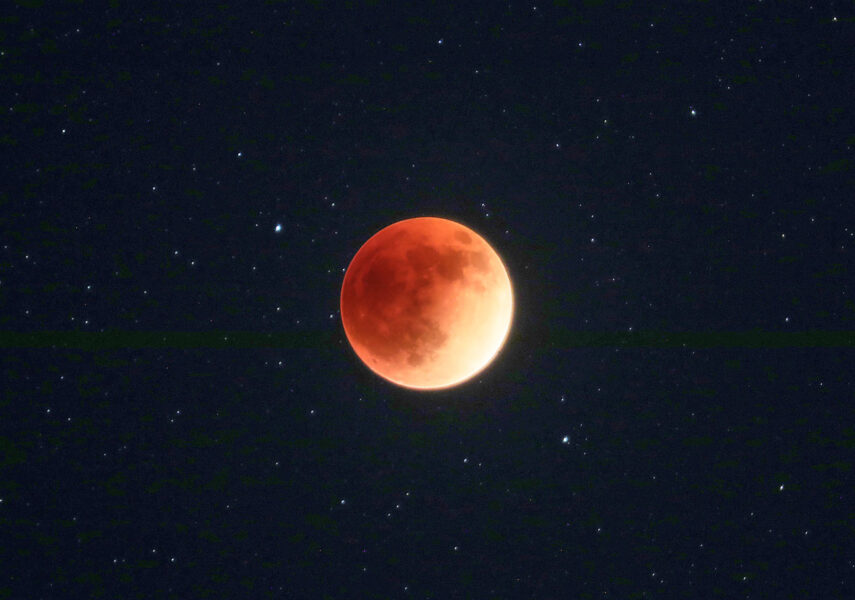
Bob King
On November 8th, U.S. observers will witness an exceedingly rare alignment of the fully eclipsed Moon and a U.S. midterm election. Just as the Earth's shadow will ink the lunar circle, millions of citizens will pick up a pen and blacken the ovals next to their favorite candidates. While predicting election results is a tricky business I can promise you this: The eclipse will be glorious, weather permitting!
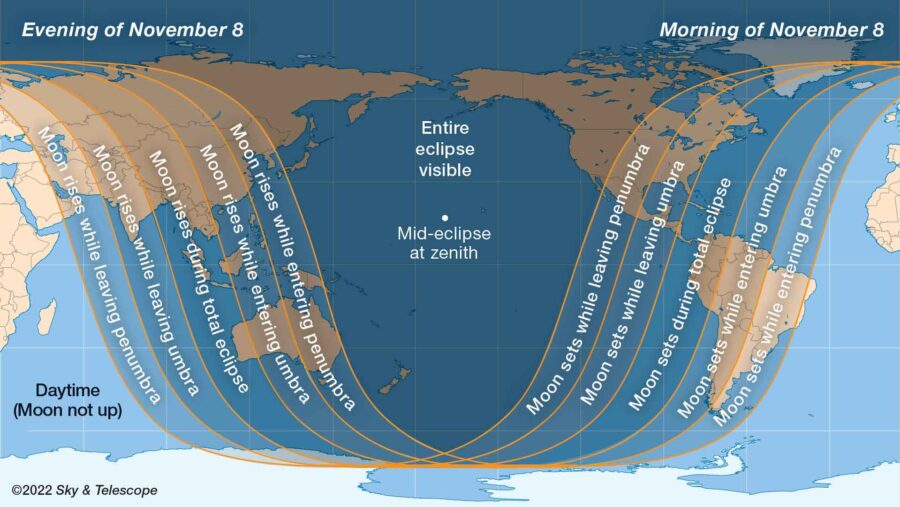
For East Coast observers the Moon will set during or shortly after totality. Farther west all phases of the eclipse will be visible.
Gregg Dinderman / Sky & Telescope; Source: USNO
North America is well placed for the show — the last total lunar eclipse visible anywhere until March 14, 2025. Observers in Asia, Australia, and the Pacific also will see the Moon's slow sweep through Earth's shadow. The entire eclipse lasts just under six hours and begins the moment the Moon's preceding limb encounters Earth's outer shadow, the penumbra. When an opaque object such as the Earth blocks the Sun, it casts a two-part shadow — a dark, inner umbra within which the Sun is completely blocked from view, and an outer, pale-gray penumbra.
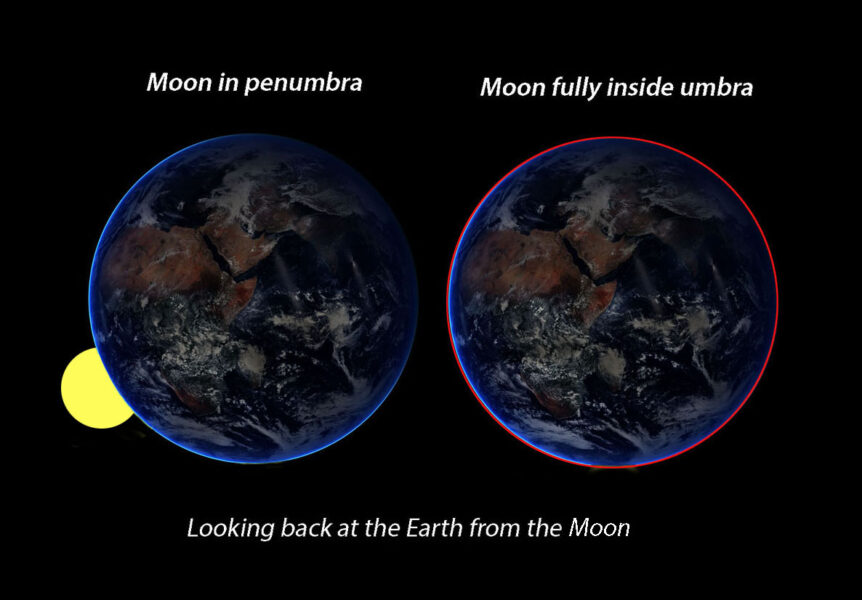
Earth image: NASA; Illustration: Bob King
Looking back at the Earth from within the penumbra, we'd see that the planet only partially covers the Sun, allowing the remaining sunlight to cast light into the shadow and leaven the darkness. This is why the penumbra appears pale gray compared to the umbra's dark chocolate. Earth's shadow also has fuzzy edges because the Sun is an extended light source. Light from different parts of the disk penetrates and softens the shadow's fringes. Look at your own shadow on a sunny day, and you'll see it's likewise bordered by a penumbra. If the Sun were a point source, edges would be sharp and well-defined.

Sky&Telescope graphics
Typically, penumbral shading only becomes visible about 20 minutes to a half-hour before the start of partial eclipse, when the Moon first contacts the umbra. As it progresses more deeply into the inner shadow, the sky darkens and stars reassert themselves. When about a quarter of the Moon has entered the umbra, the shadowed portion glows a smoky orange. Each eclipse is different. At what point will you first see color with the naked eye or binoculars? When the Moon is 20 percent inside the umbra? Or 30 percent? Hint: use averted vision.
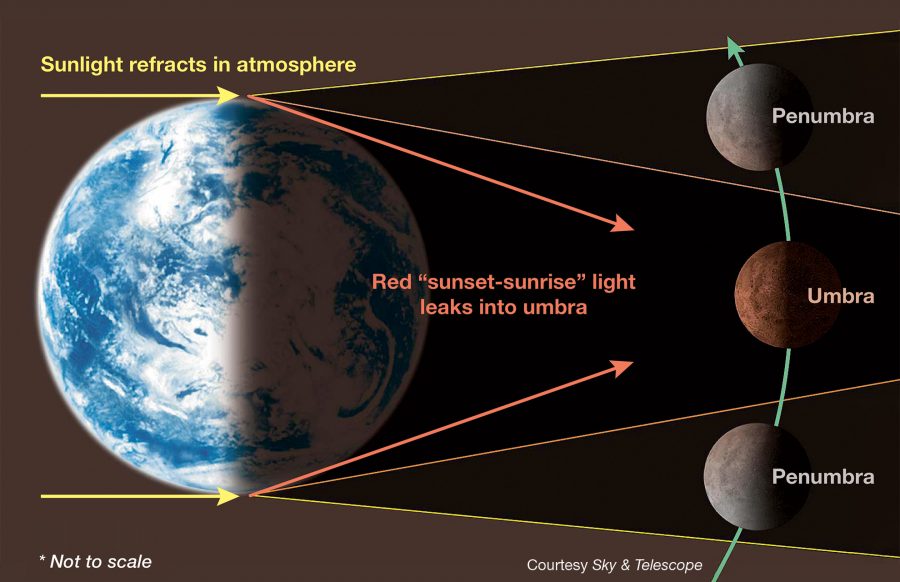
Sky & Telescope illustration
The umbra would be pitch black if Earth were air-free, and the Moon would essentially disappear during totality. But the atmosphere bends sunlight grazing the planet's circumference, scattering away the cooler colors and focusing the remaining red light into the umbra and onto the itinerant Moon, giving away its hiding place.
Totality lasts 86 minutes (from 10:16 to 11:42 UT), which is the time it takes the Moon to traverse the umbra traveling at around 3,600 kilometers per hour (2,240 mph). This eclipse will be longer than some because the Moon reaches apogee just a few days later on November 14th, when it will be most distant from Earth during its present orbit and revolving more slowly. Last May's total lunar eclipse, which was of similar depth, ended 35 minutes sooner in part because the Moon was only about a day from perigee and in more of a hurry.
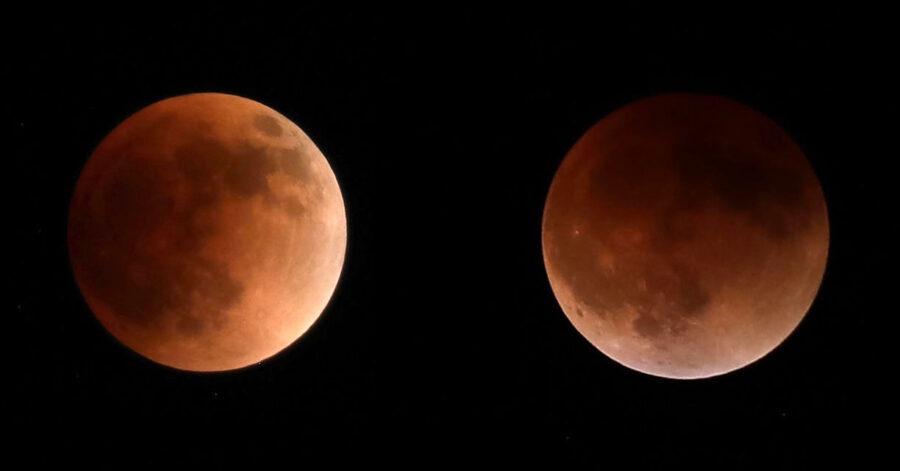
Bob King
The May and November eclipses make a complementary pair. In May, the Moon's northern limb crossed the center of the umbra at mid-eclipse. If you witnessed that eclipse you'll recall how much darker the Moon's northern half appeared compared to the southern half, which passed closer to the umbra's outer edge. Circumstances will be reversed at the upcoming eclipse, with the southern limb passing through the umbra's center. Will it appear as dark? I suspect not for two reasons. The eclipse depth will be slightly less, and the bright lunar highlands that dominate the southern hemisphere will help to counter the umbra's darkness. In May's eclipse, the dark, maria-rich northern hemisphere complemented the umbra.
Sights and insights
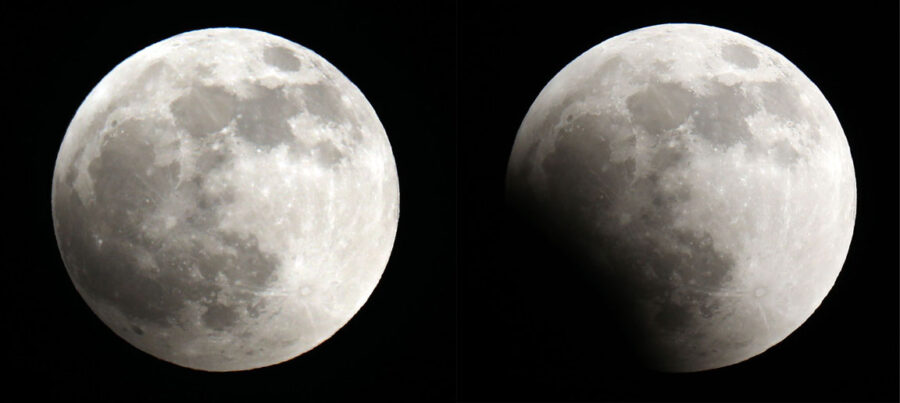
Bob King
Here are a few things to watch for during the eclipse:
1. The curve of Earth's shadow across the Moon is round. Greek astronomers of the 5th century BC argued that this was proof of the planet's spherical nature. Only a spherical body will cast the same circular shadow on the Moon from different locations and at different eclipses. Share with your Flat Earth friends.
Eclipse phases by time zone
| Eclipse Event | UT | AST | EST | CST | MST | PST | AKST | HST |
| Penumbra first visible? | ~8:45 | ~4:45 a.m. | ~3:45 a.m. | ~2:45 a.m. | ~1:45 a.m. | ~12:45 a.m. | ~11:45 p.m. | ~10:45 p.m. |
| Partial eclipse begins | 9:09 | 5:09 a.m. | 4:09 a.m. | 3:09 a.m. | 2:09 a.m. | 1:09 a.m. | 12:09 a.m. | 11:09 p.m. |
| Total eclipse begins | 10:16 | 6:16 a.m. | 5:16 a.m. | 4:16 a.m. | 3:16 a.m. | 2:16 a.m. | 1:16 a.m. | 12:16 a.m. |
| Mid-eclipse | 10:59 | 6:59 a.m. | 5:59 a.m. | 4:59 a.m. | 3:59 a.m. | 2:59 a.m. | 1:59 a.m. | 12:59 a.m. |
| Total eclipse ends | 11:42 | — | 6:42 a.m. | 5:42 a.m. | 4:42 a.m. | 3:42 a.m. | 2:42 a.m. | 1:42 a.m. |
| Partial eclipse ends | 12:49 | — | — | 6:49 a.m. | 5:49 a.m. | 4:49 a.m. | 3:49 a.m. | 2:49 a.m. |
| Penumbra last visible? | ~13:15 | — | — | — | ~6:15 a.m. | ~5:15 a.m. | ~4:15 a.m. | ~3:15 a.m. |
2. As the Moon approaches and enters totality and then again as it exits, watch for a pale blue "rind" or band of color along along the globe's outer edge caused by the ozone layer, which absorbs red light. Noctilucent clouds glow blue for the same reason.
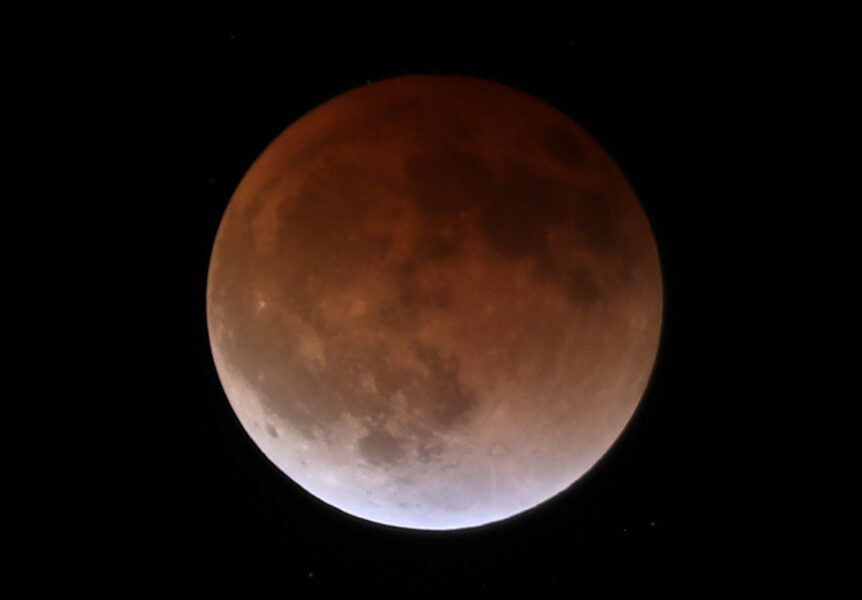
Bob King
3. How dark will the Moon become during totality? What colors does it show? Both are affected by the amount of atmospheric dust and aerosols (particularly volcanic particulates) as well as cloud cover along Earth's limb at the time of eclipse. Use the Danjon Scale to estimate its brightness, and share your report with Sky & Telescope in the comments section below. You can also estimate the Moon's overall magnitude at mid-totality using the "backwards" binoculars method (instructions here) and send your results and Danjon numbers to Brazilian amateur astronomer Helio Carvalho at [email protected]. Carvalho will analyze them, and I'll share his results in a later post.
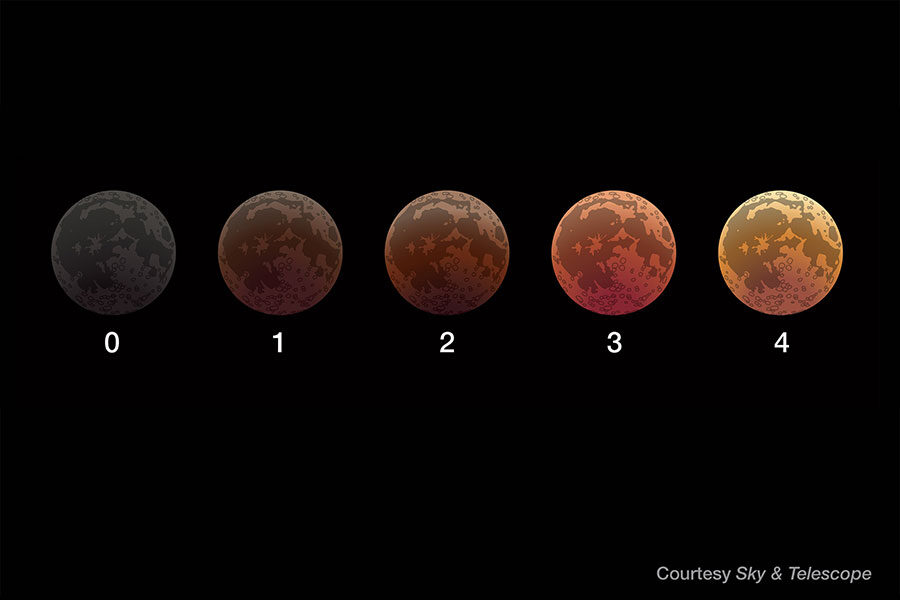
Sky & Telescope illustration
4. You can observe a lunar eclipse from almost anywhere, but totality is best experienced from the countryside. There you can fully experience the profound change from light to dark as the stars and Milky Way return in full splendor for well over an hour. The transition from light to dark to light again, although slow by total solar eclipse standards, is nothing less than majestic.
5. The Northern and Southern Taurid meteor showers, along with the Taurid Swarm, will all be active through mid-November. Not only will that mean flashes overhead for earthlings but also the possibility of seeing a meteorite impact visually or by video camera on the totally eclipsed Moon. Keep an eye peeled or set up a second telescope with a camera.
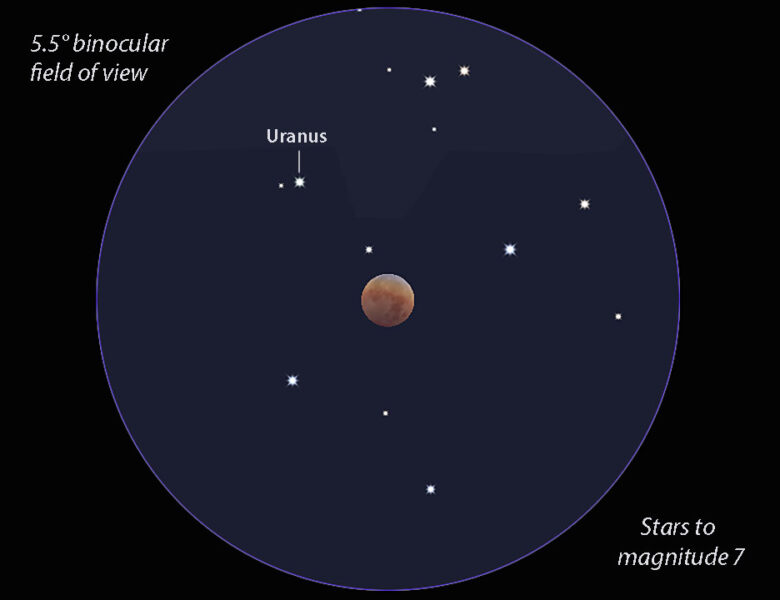
Stellarium
6. Bonus! During totality, the Moon will pair up with Uranus. From Boston, the 6th-magnitude planet glimmers about 1.8° due east of the Moon just before the end of totality. Viewers in Seattle will see them 1° apart, while observers in the Anchorage, Alaska, region can watch the Moon occult Uranus during the latter half of the partial eclipse. Check here for details.
Photography and live-streaming
For those wanting to capture images of the big event I recommend Xavier Jubier's Shutter Speed Calculator for Lunar Eclipses (which allows for lots of customization) and Fred Espenak's guide How to Photograph a Lunar Eclipse. Observers from the East Coast to the mountain states, where portions of the eclipse occur in morning twilight, will be able to include foregrounds and blue sky in their images.
If clouds threaten, Italian astronomer Gianluca Masi will live-stream the eclipse on his Virtual Telescope site starting at 09:30 UT (4:30 a.m. EST) on November 8th. You'll find additional streaming options from Griffith Observatory (3–9 a.m. EST), High Point Scientific (starting 4 a.m. EST), and Kopernik Observatory (starting 2:30 a.m. EST). Don't forget to set your alarm!
Wishing you and your family a wonderful morning under a transformed Moon. Oh, one last thing. Don't forget to vote.
If you're interested in helping scientists measure the size of Earth's shadow during the eclipse, here are some fun projects you can engage in!
 14
14







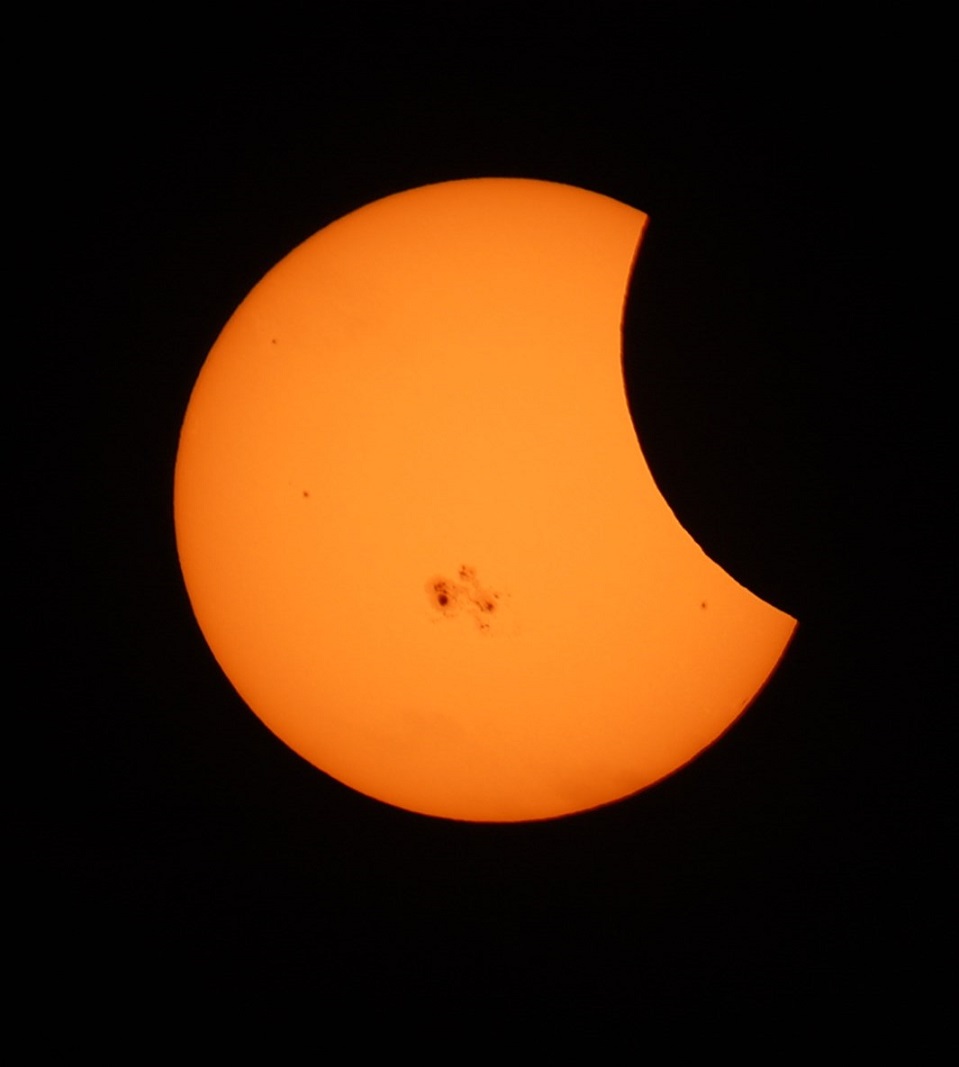

Comments
Anthony-Mallama
November 2, 2022 at 8:06 pm
We will miss the ending of this event from here in the eastern US. However, the panorama of the eclipsed moon setting over the western horizon during morning twilight should be especially picturesque. I am looking forward to observing it. Thanks for this article, Bob.
You must be logged in to post a comment.
Bob KingPost Author
November 3, 2022 at 1:18 pm
Hi Anthony,
Thank you. I agree about the scenic potential. That also goes for where I live in the Midwest. I'm eager and hopeful as the day approaches and wish you clear skies.
You must be logged in to post a comment.
Chris-Schur
November 3, 2022 at 1:19 pm
Great graphics Bob, I see two opportunities for imagers here. One, is with a wide angle lens at totality to get the deep red moon on the right edge and the bright winter Milkyway on the left including Taurus and Auriga. Moon should be dim enough to get some faint stars too. The second opportunity is when the red or maroon eclipsed moon is in the same low power field as Uranus. Two objects with complimentary colors! A most unusual event for sure.
You must be logged in to post a comment.
Bob KingPost Author
November 4, 2022 at 11:25 am
Hi Chris,
I agree. I'm hoping for a Milky Way scene as well. I suspect Uranus will be the most photographed planet — knowingly or unknowingly — on eclipse night 🙂
You must be logged in to post a comment.
Fred Espenak
November 4, 2022 at 4:32 pm
Nice article Bob.
Accuweather forecast is looking really good for Arizona (I've had crappy weather for the last two TLE's) so I'm going to set up two mounts/telescopes in the backyard. Maybe even the 10" Dob for my wife to look through. And got to break out the winter warm weather gear too!
- Fred Espenak
You must be logged in to post a comment.
Bob KingPost Author
November 10, 2022 at 1:35 pm
Hi Fred,
I hope it cleared up for you. It was overcast here in Duluth, but cloud maps showed a clearing arriving over central Wisconsin. I got in the car and a little more than 2 hours later found clear skies!
You must be logged in to post a comment.
misha17
November 8, 2022 at 2:45 am
Looking at the diagram of the Moon's path through the Earth's shadow, there will be a few minutes just before the umbral eclipse begins, and just after it ends, when the Moon will be completely within the Earth's penumbra - total penumbral phases. If we were on the Moon, every part on the sunward side would see the Earth partly, but not completely, blocking the Sun.
Usually the Moon is not small enough to fit completely within the penumbra while not reaching the umbra.
You must be logged in to post a comment.
Bob KingPost Author
November 10, 2022 at 1:34 pm
Hi Misha,
Excellent point! One of the benefits of the eclipse occurring close to apogee.
You must be logged in to post a comment.
Rod
November 8, 2022 at 6:52 am
Bob King et al. I did enjoy some great eclipse viewing this morning 🙂 I posted a note with some observation details here, https://skyandtelescope.org/astronomy-news/observing-news/this-weeks-sky-at-a-glance-november-4-12-2/
I used 10x50 binoculars and 90-mm refractor telescope at 31x and did some crater timings too 🙂
You must be logged in to post a comment.
Bob KingPost Author
November 10, 2022 at 1:32 pm
Hi Rod,
Glad it was clear! And thank you for posting your observations with us.
You must be logged in to post a comment.
Anthony-Mallama
November 8, 2022 at 8:55 am
The view of totality from Bowie, MD, USA was wonderful. The faint reddish moon appeared soft and warm as compared to the hard and cold appearance of the full moon. I saw the International Space Station fly overhead and wondered whether the astronauts were watching too.
You must be logged in to post a comment.
Bob KingPost Author
November 10, 2022 at 1:32 pm
Anthony,
I totally agree about the softness of the colors, and it's fun to think that some of the astronauts may have watched. I can picture them with faces pressed up against the cupola. I rated totality at Danjon 2.
You must be logged in to post a comment.
Rich
November 9, 2022 at 8:51 pm
I do a "Full Moons to go" countdown for my friends. The next Total Lunar Eclipse is 29 Full Moon away.
You must be logged in to post a comment.
Bob KingPost Author
November 10, 2022 at 1:30 pm
Rich,
That's a lot, so let's get started: 29, 28, 27 . . .
You must be logged in to post a comment.
You must be logged in to post a comment.